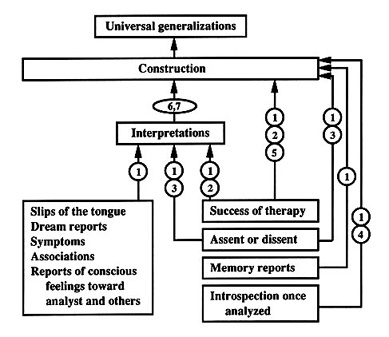Problem 7: Problems with Establishing Causal Claims by Retrospective Testing
The method of free-association, hailed by some psychoanalysts as an instrument comparable to the microscope or telescope, is not a trustworthy resource for establishing causation. Psychoanalysts such as Rapaport (1967, pp. 216-217) commit the logical falacy of post hoc ergo propter hoc--"after it, therefore the cause of it." A repression that emerges at the end of a chain of free associations is taken uncritically to be the original cause of the symptom that initiated that chain.
The figure below (Von Eckardt, 1986) represents epistemological problems in Freud's use of clinical data as discussed by Grünbaum (1984) (circled numbers correspond to numbered problems at left; arrows represent the relation "is considered evidence for").

LEVELS
PROBLEMS
- suggestibility (pp. 130-135);
- failure of tally argument (pp. 135-172);
- weakness of consilience argument (pp. 273-278);
- Nisbett and Wilson findings (pp. 147-148);
- problems with Breuer-Freud argument (pp. 177-189);
- problems with extrapolation to slips and dreams (pp. 190-239);
- problems with establishing causal claims by retrospective testing (pp. 177-189).
References
Rapaport, D. (1967). The collected papers of David Rapaport. M. M. Gill (Ed.). New York: Basic Books.
Grünbaum, A. (1984). The foundations of psychoanalysis: A philosophical critique. Berkeley, CA: University of California Press.
Von Eckardt, B. (1986). Grünbaum's challenge to Freud's logic of argumentation: A reconstruction and an addendum. The Behavioral and Brain Sciences, 9, 262-263.
Last modified January 1999
Visited times since July 2001
Comments?
Home to Psychoanalysis
Home to Great Ideas in Personality
